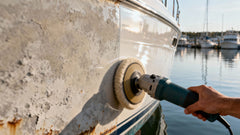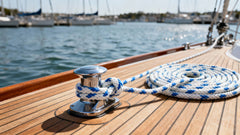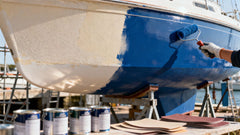How to Clean Boat Upholstery Like a Pro
Figuring out how to clean your boat's upholstery isn't rocket science. It really comes down to a few simple things: knowing what material you're working with, grabbing the right marine-grade cleaner, gently scrubbing away the grime, and finishing with a protective coat. This doesn't just make your seats look brand new; it's crucial for preventing long-term damage from sun, salt, and mildew.
Your Guide to Pristine Boat Upholstery
Keeping your boat's interior looking sharp is about way more than just appearances. It's a core part of protecting your investment and making sure every single trip on the water is comfortable and fun. Whether you're dealing with routine dirt after a great day out or tackling stubborn mildew that crept in during winter storage, having a solid game plan makes all the difference.
Think of this as your roadmap. The approach you'd take for durable marine vinyl is completely different from caring for delicate fabrics. Using the wrong product can quickly lead to faded colors, brittle cushions, or even permanent stains.
Why a Specialized Approach Matters
Let's be honest, the marine environment is brutal. Constant exposure to UV rays, saltwater, and humidity demands cleaners and protectants specifically built to handle those conditions. This is why a dedicated, marine-specific approach is absolutely non-negotiable for long-term care.
A huge mistake I see people make is grabbing a household cleaner from under the sink. Products with bleach or ammonia can strip the protective coatings right off marine vinyl, causing it to crack and fall apart way too soon. Always, always opt for a pH-balanced, marine-specific solution.
Maintaining your boat's interior is a critical part of ownership, and you're not alone in this. In fact, over 60% of boat owners regularly use specialized upholstery cleaners. The average owner spends between $50 and $150 a year on these products for common materials like vinyl, leather, and synthetic fabrics, each needing a specific solution.
To really see what's possible with a good cleaning, check out these stunning upholstery cleaning before and after transformations. With the right techniques and a little elbow grease, your boat's seats can look just as impressive.
For a quick reference, here's a simple breakdown of what to use for the most common materials you'll find on a boat.
Upholstery Cleaning at a Glance
| Upholstery Material | Recommended Cleaner | Essential Cleaning Tip |
|---|---|---|
| Marine Vinyl | Better Boat Vinyl Cleaner | Use a soft-bristle brush in circular motions to lift embedded dirt without scratching the surface. |
| Canvas & Fabric | Fabric Cleaner with UV Protectant | Test on a small, hidden area first to ensure colorfastness. Allow it to air dry completely. |
| Leather | Marine Leather Cleaner & Conditioner | Apply conditioner after cleaning to keep the leather supple and prevent it from drying and cracking. |
| Faux Leather | Mild Soap & Water or Vinyl Cleaner | Wipe down with a damp microfiber cloth immediately after cleaning to remove any soap residue. |
This table should give you a great starting point. Remember, the key is matching the right product and technique to the material you have.
Putting Together Your Boat Cleaning Arsenal
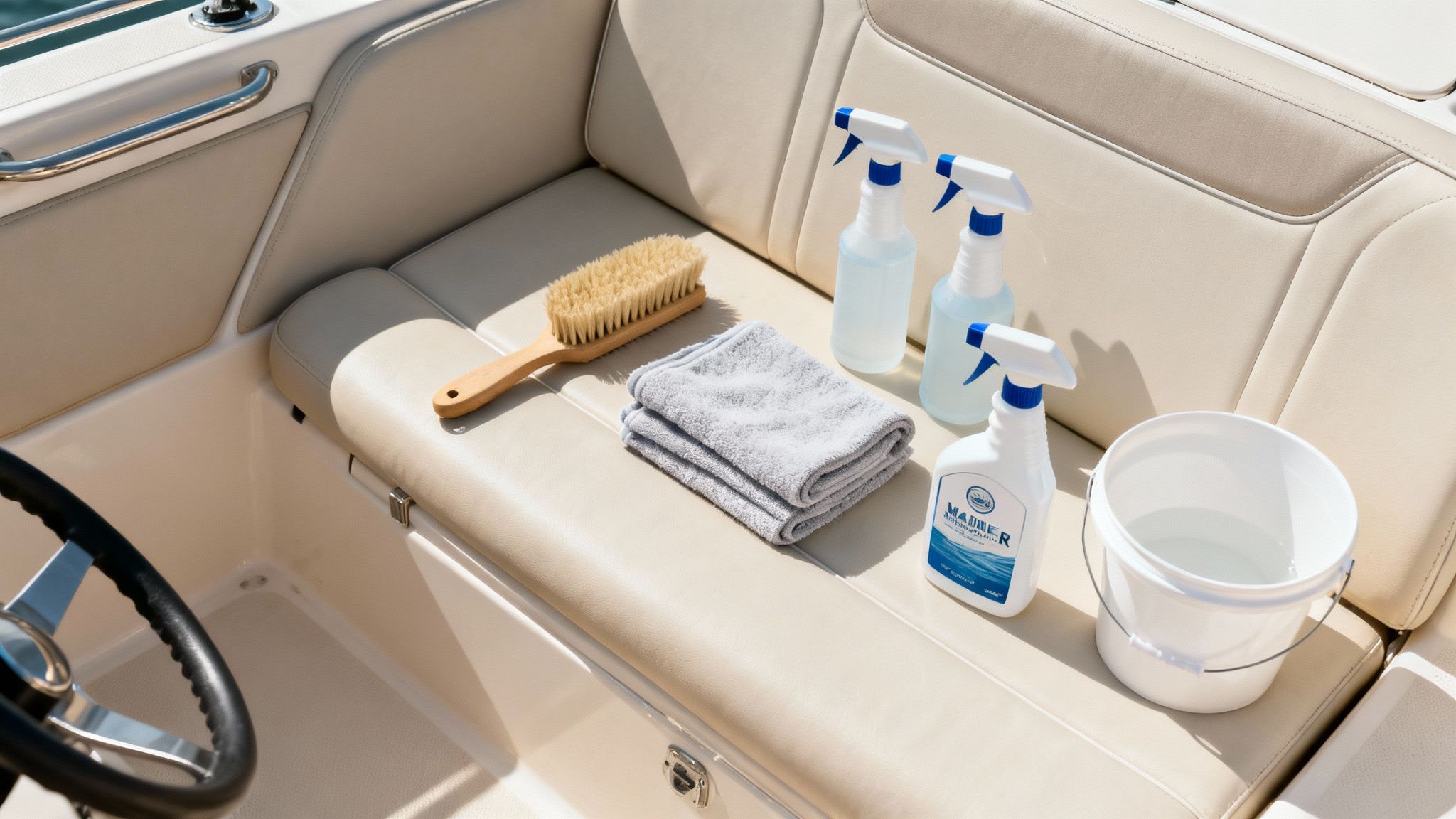
Having the right gear on hand makes cleaning your upholstery less of a chore and more of a quick, satisfying job. This isn't just about grabbing a random bucket and soap; it's about building a smart toolkit specifically for the challenges of a marine environment. The right stuff not only works faster but also protects your boat's interior from damage.
The foundation of any good kit is the basics. A soft-bristle brush is non-negotiable for getting into the grain of the vinyl and lifting out dirt without causing scratches. Just as important is a good stack of quality microfiber towels for wiping everything down without leaving lint behind.
Picking the Right Cleaners
For the everyday stuff—think dirty footprints, sunscreen smudges, and general grime after a day on the water—our Vinyl Cleaner is the perfect workhorse. It’s formulated to be tough on dirt but completely safe for all the materials you find on a boat.
But let's be real, some messes need a specialist. When you spot those ugly, dark mildew stains that seem to pop up from nowhere, you need something with more targeted power. Our Mildew Stain Remover is engineered to wipe out mildew without using harsh bleach that can eat away at vinyl and fade your colors over time.
A common mistake is thinking one cleaner does it all. Using a dedicated mildew remover for mold and an all-purpose cleaner for regular dirt gives you the best results without putting extra wear on your upholstery.
Beyond the cleaners, you'll want to round out your toolkit with a few other essentials:
- Two Buckets: One for your cleaning mix, and a second one with clean water for rinsing. This stops you from just spreading dirty water back onto your seats.
- Spray Bottles: These are great for diluting cleaners or for rinsing smaller spots with fresh water without soaking everything.
- A Good Vacuum: A handheld, portable vacuum is perfect for sucking up all the loose sand, crumbs, and whatever else finds its way onto the seats before you start scrubbing.
Getting your toolkit right is the first real step toward getting professional-level results. If you want to dive deeper into building out the ultimate supply stash, check out our complete guide to a comprehensive boat cleaning kit.
The Critical Pre-Cleaning Inspection

I know the temptation. You see the grime, and you just want to jump right in and start scrubbing. But trust me on this—that's a rookie mistake that can actually set stains or even damage your vinyl. The real first step, the one that pros never skip, is a quick but thorough inspection. It’s all about diagnosing the problem before you try to treat it.
Take a good look at your seats. What are you actually dealing with? Is it the greasy film from sunscreen? Dark rings from a spilled soda? Or are you seeing those dreaded fuzzy spots that signal mildew is setting in? Each one of these culprits needs a slightly different battle plan.
Identify and Spot-Test
Once you know what you’re up against, it’s time for a spot test. This is non-negotiable, folks. It’s the single best way to avoid a cleaning disaster like widespread discoloration or fading.
Find a small, out-of-the-way area to test your cleaner—think the underside of a cushion or a patch of vinyl hidden behind a seat. Apply a little bit of your cleaning solution and let it sit for a few minutes.
Always test your cleaning solution on an inconspicuous spot first. Wait a few minutes and wipe it clean to ensure it doesn't cause any fading or adverse reactions with your specific upholstery material.
This simple step gives you the green light to proceed with confidence. If you've spotted mildew, for example, this is where you'd test a dedicated mold and mildew remover. That can be a tough battle, so you might want to check out our complete guide on how to remove mold from boat upholstery for more specialized tactics.
Prep the Surface for a Deeper Clean
The last part of your pre-clean routine is getting the surface ready. Before a single drop of cleaner hits the fabric, grab a vacuum with a soft brush attachment. You'll want to go over every single seam, crease, and flat surface to pull up all the loose dirt, sand, and other debris.
This is more important than you might think. If you skip the vacuuming, you’re just grinding those abrasive particles into the material as you scrub. Over time, that creates tiny scratches and wears down your upholstery much faster. A quick vacuum ensures you're fighting the stains, not the sand.
Mastering the Deep Cleaning Process
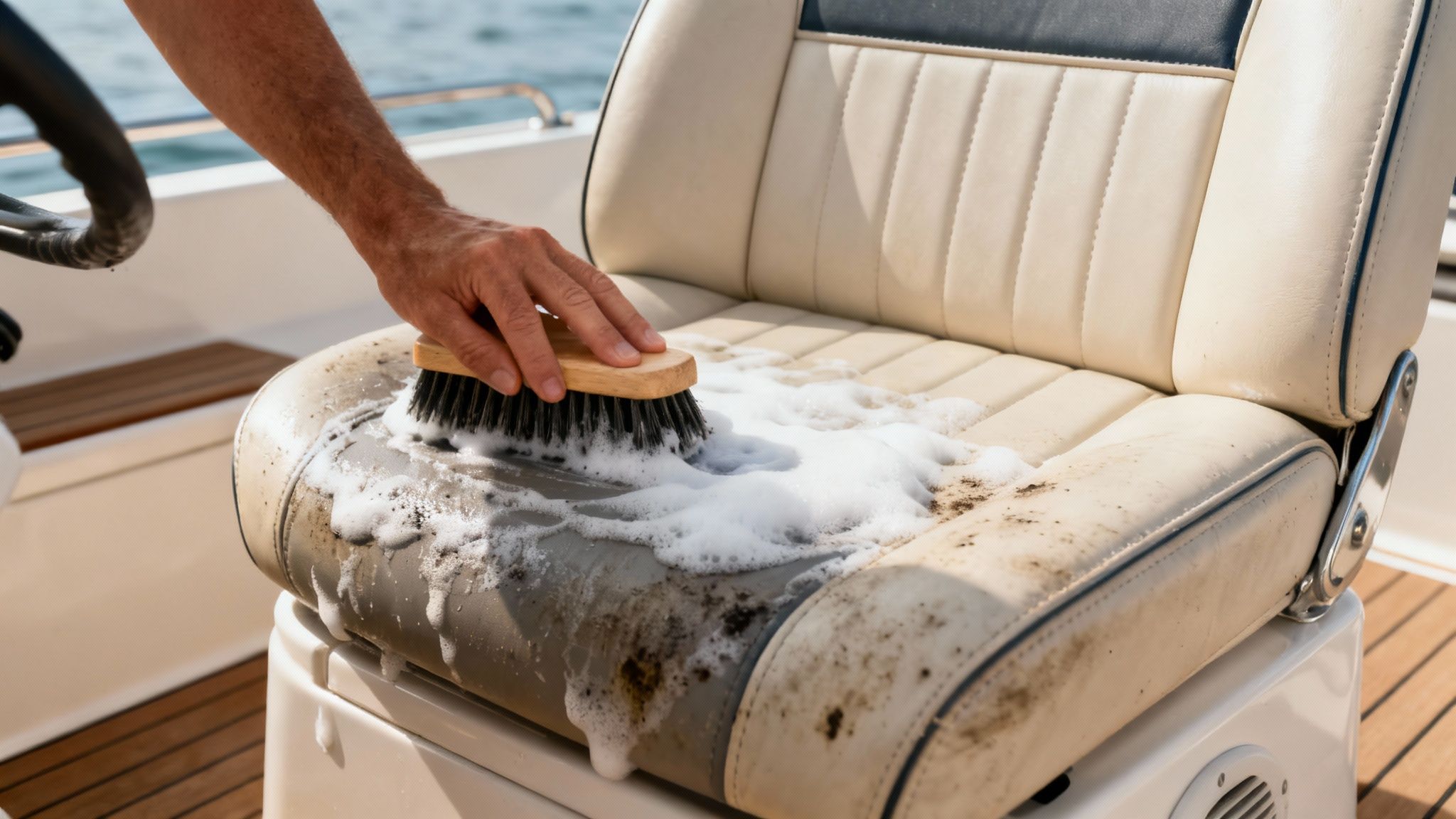
Alright, with the initial inspection and surface prep out of the way, it’s time to roll up your sleeves for the part that delivers those dramatic, satisfying results. The technique changes a bit depending on what you're working with, but the goal is always the same: lift away all that embedded grime and bring back that fresh look without causing any damage.
Most boats these days have marine vinyl, and thankfully, the process is pretty straightforward. You just need the right touch.
Start by lightly spraying a section of the seat with a quality marine cleaner. Our Vinyl Cleaner is pH-balanced, so it's designed to break down everything from dirt to sunscreen residue without stripping the vinyl's protective topcoat.
Let the cleaner sit for about a minute. Seriously, don't skip this. That "dwell time" is what allows the solution to really penetrate and dissolve the grime. Rushing this step just means you’ll be scrubbing harder and longer than you need to, which can wear down the material over time.
The Gentle Art of Agitation
Once the cleaner has worked its magic, it's time to agitate the surface. Grab a soft-bristled brush and gently scrub the vinyl in small, circular motions. This is the secret to lifting dirt out of the textured grain of the vinyl—exactly where grime loves to hide.
Remember, you don't need a lot of muscle here. Let the cleaner and the brush bristles do the heavy lifting for you.
After you've worked a section, immediately wipe it clean with a damp microfiber towel. Then, follow up with a separate dry towel to soak up every bit of moisture. Pay close attention to the seams where water can pool and eventually lead to mildew.
For a deeper dive into different methods, you can check out our detailed guide on how to clean boat seats right.
Tackling Fabric and Mildew
If your boat has fabric upholstery, the golden rule is to avoid soaking it. Lightly mist a fabric-safe cleaner onto the surface and use a soft brush or microfiber cloth to blot and lift the stains away. Drenching fabric cushions traps moisture deep inside the foam, creating a perfect breeding ground for mold.
Of course, no guide on cleaning boat upholstery would be complete without talking about every boater’s nemesis: mildew. Those ugly black spots require a targeted attack. For this job, you need a specialized solution like our Mildew Stain Remover.
Here's a pro tip: Don’t make the common mistake of reaching for household bleach. It’s way too harsh for marine vinyl and can cause irreversible damage, making it brittle and cracked. A dedicated marine mildew remover is always the safer, more effective choice.
To use it, just apply the remover directly to the stained areas and let it sit for several minutes. You’ll often see the stains begin to fade right before your eyes. Gently scrub the spot with your soft brush, then rinse the area thoroughly with fresh water and dry it completely. This not only gets rid of the existing stains but also helps stop them from coming back.
Protecting Your Upholstery for the Long Haul
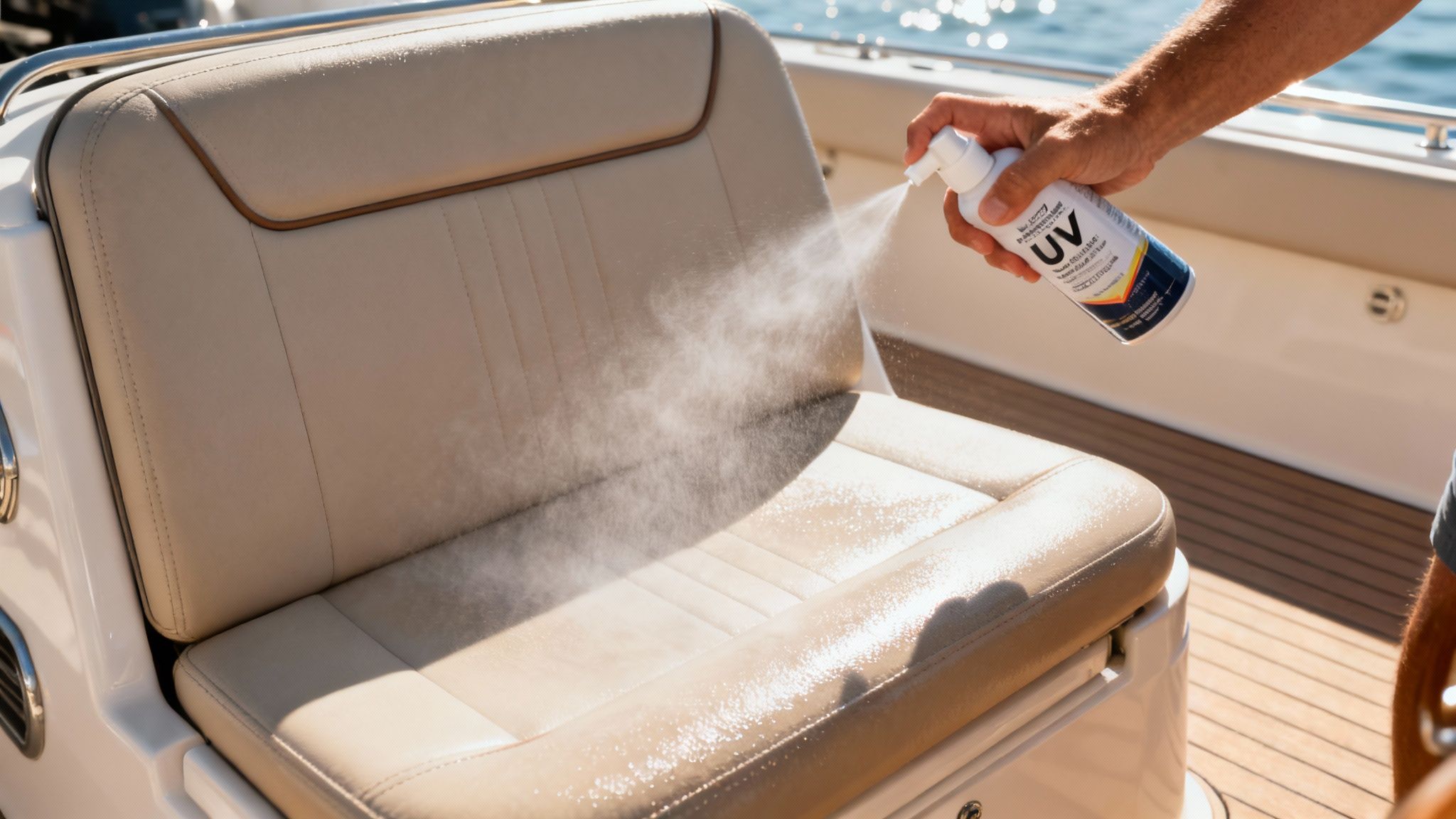
Getting your boat seats looking brand new again is a great feeling. But if you stop there, you’ll be doing the same deep clean all over again before you know it. The real secret to keeping that fresh look is locking it in with a high-quality marine protectant. This isn't just an extra step; it's the armor your upholstery needs to fight off the elements.
Think of it as sunscreen for your vinyl. The sun is absolutely relentless, and its UV rays are constantly breaking down your boat's surfaces. That’s what leads to the cracking, fading, and brittleness you see on so many older boats. A good protectant puts a barrier between your seats and that harsh sun.
Applying a Lasting Barrier
Our Boat UV Protectant Spray was made specifically for this. Once your seats have had a chance to completely dry after cleaning, just mist a light, even coat over the whole surface. Follow it up with a clean microfiber towel to gently wipe it in, making sure you get full coverage without any thick, greasy spots.
Don't go overboard and saturate the seats. A thin, even layer is way more effective than a thick, sticky mess. You're aiming for an invisible shield, not a slippery film.
Making this a regular habit—maybe every few weeks during the height of boating season—is what really builds up a solid defense. Not only does it stop UV damage in its tracks, but it also helps repel water and makes your next cleanup a whole lot easier. To get the full picture, you can learn more about the benefits of a dedicated marine vinyl cleaner and see how it works hand-in-hand with a protectant.
Simple Habits for Long-Term Preservation
Beyond using a good spray, a few simple routines can make a world of difference in how long your upholstery lasts. These small habits add up in a big way:
- Use Quality Boat Seat Covers: When the boat is docked or stored, covers are your number one defense against sun, rain, and bird droppings.
- Ensure Proper Ventilation: Mildew loves trapped moisture. If your boat is covered, use vents or even a small dehumidifier to keep the air moving.
- Wipe Down After Use: Take two minutes to wipe down the seats with a dry towel. This gets rid of salt spray and spills before they have a chance to stain.
When you combine a top-tier protectant with these smart habits, you’ll find yourself spending less time scrubbing and more time enjoying a boat that looks amazing season after season.
Common Questions About Cleaning Boat Upholstery
Even with the best game plan, you're bound to run into a few tricky situations when cleaning your boat's upholstery. I've heard just about every question in the book, and getting the right answer quickly can be the difference between a pristine finish and a costly mistake.
Here are a few of the most common questions that pop up.
How Often Should I Clean My Boat Upholstery?
Ideally, you’ll want to give your seats a quick wipe-down with a damp microfiber cloth after every single trip. Think of it as preventative maintenance—it gets the fresh salt spray and minor spills off before they have a chance to bake in.
As for a deep clean, put it on your calendar for the beginning and end of each boating season, no exceptions. That said, if your boat lives in a particularly humid spot (hello, Florida!), you’ll likely need to do a thorough cleaning more often to fight off that relentless mildew.
Can I Use Household Bleach on My Seats?
This is a big one, and the answer is a hard no. I can't stress this enough: stay away from household cleaners like bleach or ammonia when you're cleaning marine upholstery.
These chemicals are just too harsh for marine-grade vinyl and fabrics. They’ll strip away the protective coatings that prevent UV damage, make the material brittle and prone to cracking, and can cause permanent, ugly color fading.
Stick with products specifically formulated for marine use. They are designed to be tough on stains without compromising the integrity of your upholstery.
What Is the Best Way to Remove Sunscreen Stains?
Ah, the dreaded sunscreen stain. It’s one of the trickiest to handle because of its oily base. The key is to act fast. Blot a fresh stain immediately with a clean, dry cloth to soak up as much as you can.
For a stain that’s already set, your best bet is a dedicated marine vinyl cleaner. Just spray our Vinyl Cleaner on and let it sit for a minute or two—you need to give it time to break down those stubborn oils. Then, come in with a soft-bristled brush and gently scrub the area. Rinse it completely with fresh water and let it air dry.
For every challenge your boat's interior faces, Better Boat has a solution. From our powerful Mildew Stain Remover to our daily-use Vinyl Cleaner, our products are designed to deliver professional results with ease. Explore our complete collection of boat care supplies at betterboat.com and keep your vessel looking pristine all season long.


